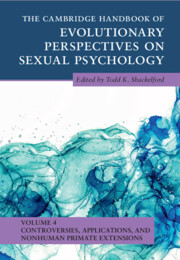Book contents
- The Cambridge Handbook of Evolutionary Perspectives on Sexual Psychology
- The Cambridge Handbook of Evolutionary Perspectives on Sexual Psychology
- Copyright page
- Contents
- Contributors
- Preface
- Part I Controversies and Unresolved Issues
- Part II Applications to Health, Law, and Pornography
- Part III Nonhuman Primate Sexual Behavior
- 14 Chimpanzee Sexual Behavior
- 15 Bonobo Sexual Behavior and Psychology
- 16 Orangutan Sexual Behavior
- 17 Gibbon Evolved Sexual Psychology
- 18 Sexual Behavior in Marmosets in the Context of Cooperative Breeding
- 19 Capuchin Sexual Behavior
- 20 Sexual Behavior in Neanderthals
- Index
- References
20 - Sexual Behavior in Neanderthals
from Part III - Nonhuman Primate Sexual Behavior
Published online by Cambridge University Press: 30 June 2022
- The Cambridge Handbook of Evolutionary Perspectives on Sexual Psychology
- The Cambridge Handbook of Evolutionary Perspectives on Sexual Psychology
- Copyright page
- Contents
- Contributors
- Preface
- Part I Controversies and Unresolved Issues
- Part II Applications to Health, Law, and Pornography
- Part III Nonhuman Primate Sexual Behavior
- 14 Chimpanzee Sexual Behavior
- 15 Bonobo Sexual Behavior and Psychology
- 16 Orangutan Sexual Behavior
- 17 Gibbon Evolved Sexual Psychology
- 18 Sexual Behavior in Marmosets in the Context of Cooperative Breeding
- 19 Capuchin Sexual Behavior
- 20 Sexual Behavior in Neanderthals
- Index
- References
Summary
Improved clarity of Neanderthal ways of life brought about by advancements in analysing the fossil and archaeological records, accompanied by increased willingness to accept complex Neanderthal cognition, makes it appropriate to begin to understand their sexual behavior. In this chapter, we briefly review current understandings about Neanderthals based on anatomy, genetics, and behavior evidenced from the archaeological record. We then integrate this with broad behavioral ecology and evolutionary sexual selection concepts to consider potential selection pressures on Neanderthals’ sexual and reproductive behaviors. Large adult brain size, rapid infant brain growth, and protracted offspring development, similar to Homo sapiens, were supported by adaptations in social organization, mating and parental effort. It is likely that male provisioning and investment in offspring strengthened reproductive pair bonds, improved infant survival, and impacted mate choice in both sexes. Systematic collaborative subsistence strategies were probably matched by a heavy reliance on kin and other trusted adults within the cooperative breeding group, reducing the energy burden on reproducing females, and enabling shorter lactation and reduced interbirth intervals. Neanderthals’ wide ecological tolerances and behavioral flexibility suggest that they also adjusted their sexual and reproductive behavior according to environmental circumstances. Small group size, local-to-regional social networks and potentially seasonal breeding enabled populations to adapt to fluctuating energy availability. During harsher climatic phases, limited access to mating opportunities may have favored social monogamy, with genetic isolation and inbreeding more likely. When conditions were milder (during interglacials, in warmer regions or seasons) with more plentiful resources, group sizes and social networks may have permitted polygyny. Finally we explore the behavioral implications of genetic evidence that Neanderthals interbred with other hominins including H. sapiens. This suggests that differences in physical appearance and social structures did not prevent copulation or raising hybrid infants, although sterility and lower fitness of the latter may have limited the spread of genes between species.
Keywords
- Type
- Chapter
- Information
- Publisher: Cambridge University PressPrint publication year: 2022
References
- 1
- Cited by



